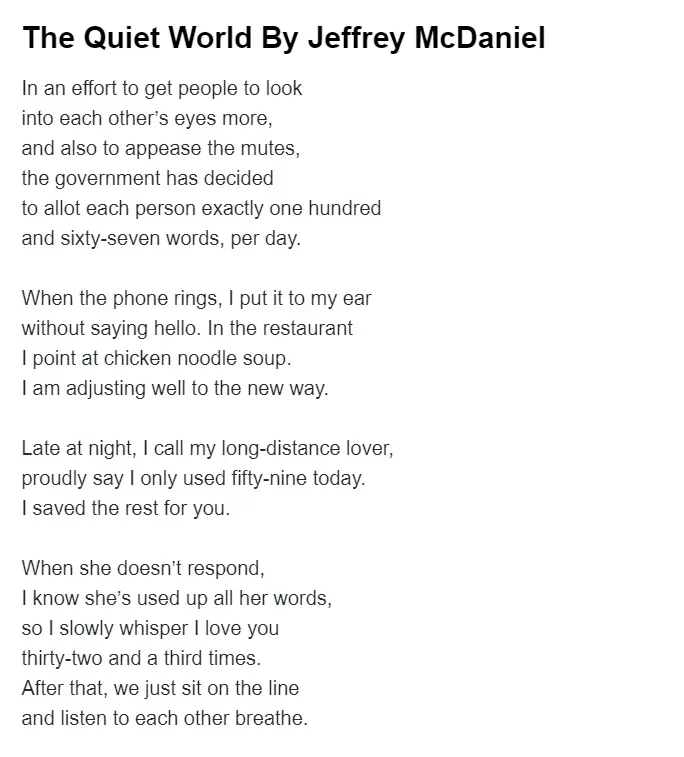The Quiet World By Jeffrey McDaniel
Summary Of The Quiet World By Jeffrey McDaniel
Brief Synopsis
“The Quiet World” by Jeffrey McDaniel imagines a dystopian society where people are limited to using 167 words per day. This regulation is aimed at encouraging meaningful interactions and accommodating those who are mute.
The poem explores the daily life adjustments that come with such a restriction, like answering the phone without greeting and ordering food through gestures.
It poignantly portrays a conversation between the speaker and a long-distance lover, highlighting the preciousness of words in expressing love.
The poem ends with the lovers listening to each other breathe, emphasizing the depth of connection beyond words.
Main Themes
Love and Communication: The poem delves into how the limitation of words affects relationships, underscoring the value of words in expressing love and emotions.
The speaker saves words for meaningful conversations with his lover, symbolizing the weight and value of each word spoken.
Isolation and Connection: It reflects on the solitude and isolation imposed by limited speech, contrasting it with the profound, wordless connections that can form between individuals. The silence shared by the lovers represents a deep, intrinsic connection.
Societal Restrictions: The poem critiques societal norms and restrictions, suggesting that limitations on communication can lead to a more introspective and meaningful existence, yet also highlighting the potential for enforced silence to isolate individuals.
Structure and Form
Type of Poem
“The Quiet World” is a free verse poem. Free verse allows for flexibility in expression, which aligns with the poem’s exploration of constrained communication.
Stanza and Line Structure
The poem is written in a single stanza, comprising a series of lines that vary in length. This structure mirrors the fluidity and unpredictability of daily interactions under word restrictions.
The lack of rhyme scheme and traditional stanza breaks emphasizes the free-flowing nature of thoughts and conversations within a confined word limit.
Analysis
Literary Devices
Metaphors and Similes
McDaniel employs metaphors to highlight the emotional weight of communication. The restriction of words serves as a metaphor for the limitations we often place on our emotional expressions.
Imagery
The poem creates vivid imagery, such as pointing at chicken noodle soup in a restaurant, which helps readers visualize the mundane yet poignant reality of life under such constraints.
The act of whispering “I love you” 32.3 times is a powerful image that conveys the struggle to communicate within imposed limits.
Symbolism
Words symbolize freedom and expression, while the daily limit of 167 words represents societal constraints on personal interactions.
The silence at the poem’s end symbolizes a deeper, non-verbal connection between the lovers, suggesting that true intimacy transcends spoken language.
Language and Diction
Choice of Words and Tone
McDaniel’s diction is straightforward and unembellished, reflecting the everyday speech patterns of the characters.
The tone is contemplative and introspective, conveying a sense of acceptance and adaptation to the new communication norms.
Syntax and Sentence Structure
The syntax is simple and unadorned, mirroring the minimalist communication style necessitated by the word limit. This simplicity enhances the emotional impact of the poem, making each word carry significant weight.
Rhythm and Meter
Analysis of Rhythm
The poem lacks a consistent rhythm, reflecting the irregular and constrained flow of communication within the 167-word limit. The varying line lengths contribute to a sense of unpredictability and constraint.
Discussion of Meter
As a free verse poem, it does not adhere to a specific meter, which allows the poet to emphasize the natural cadence of speech under the constraints of limited words.
Sound and Rhyme
Use of Rhyme Schemes
The poem does not utilize a rhyme scheme, which aligns with its free verse form. The absence of rhyme emphasizes the focus on content and the weight of each word rather than on sound patterns.
Alliteration and Assonance
McDaniel uses subtle sound devices such as alliteration and assonance to enhance the musicality of the poem. Phrases like “proudly say I only used fifty-nine” utilize the repetition of the ‘s’ sound to create a soft, whisper-like quality, reflecting the intimate tone of the poem.
Interpretation
Poet’s Intent and Message
Possible Interpretations
McDaniel’s poem can be interpreted as a commentary on the power of words and the importance of meaningful communication.
The word limit forces individuals to prioritize their speech, highlighting the value of each word. It suggests that sometimes, silence and non-verbal communication can convey emotions more profoundly than words.
Insights into the Poet’s Perspective
The poet seems to critique the superficial nature of modern communication and suggests a return to more meaningful, intentional interactions.
The poem reflects a belief in the power of love and connection, even when words are scarce, and underscores the idea that true intimacy can transcend verbal expression.
Images:

References and Citations
“Jeffrey Mcdaniel.” Jeffrey Mcdaniel, 2016, www.jeffreymcdaniel.net/. Accessed 19 June 2024.
Wikipedia Contributors. “Jeffrey McDaniel.” Wikipedia, Wikimedia Foundation, 16 Nov. 2023, en.wikipedia.org/wiki/Jeffrey_McDaniel. Accessed 19 June 2024.
